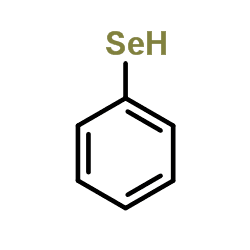Formula C6H6Se Density 1.48 g/cm³ | Molar mass 157.07 g/mol Appearance colorless liquid | |
 | ||
Related compounds | ||
Benzeneselenol is the organoselenium compound with the formula C6H5SeH, often abbreviated PhSeH. It is the selenium analog of the simple aromatic alcohol phenol, and the related thiol thiophenol. This colourless, intensely malodorous compound is a useful reagent in organic synthesis.
Contents
Synthesis and basic properties
Benzeneselenol is prepared via the reaction of phenylmagnesium bromide and selenium:
PhMgBr + Se → PhSeMgBrPhSeMgBr + HCl → PhSeH + MgBrClMore so than thiophenol, benzeneselenol is easily oxidized by air. The product is diphenyl diselenide as shown in this idealized equation:
4 PhSeH + O2 → 2 PhSeSePh + 2 H2OThe presence of the diselenide is indicated by a yellow coloration in most samples of PhSeH. The diselenide can be converted back to the selenol by reduction followed by acidification of the resulting PhSe−.
PhSeH is approximately seven times more acidic than the related thiophenol. Both compounds dissolve in water upon the addition of base.
In organic synthesis benzeneselenol is converted to its conjugate base PhSe−, a potent nucleophile.
History
Benzeneselenol was first reported in 1888 by the reaction of benzene with selenium tetrachloride (SeCl4) in the presence of aluminium trichloride (AlCl3).
Safety
The compound is intensely malodorous and, like other organoselenium compounds, toxic.
